Kinship, Family, and Marriage in Human Societies: ANTH 101 Essay
VerifiedAdded on 2022/09/25
|8
|2148
|25
Essay
AI Summary
This essay explores the fundamental institutions of kinship, family, and marriage in human societies, emphasizing their significance in shaping individual identities and social structures. The paper delves into the family's role as a primary social unit, examining sociological and anthropological perspectives on its diverse manifestations and structures across different cultures. It discusses the structural-functional and conflict theories, highlighting how families contribute to social cohesion, transmit cultural values, and perpetuate social inequalities. The essay also examines the evolution of kinship theory, from terminological classifications to the understanding of social relations and the impact of conjugal associations. Furthermore, it explores marriage patterns, their variations globally, and the influence of modernity and feminist perspectives on these institutions. The conclusion underscores the importance of studying kinship, families, and marriage in anthropology to understand human interactions and societal functioning.

Running head: KINSHIP, FAMILY AND MARRIAGE IN HUMAN SOCIETIES
KINSHIP, FAMILY AND MARRIAGE IN HUMAN SOCIETIES
Name of the Student:
Name of the University:
Author note:
KINSHIP, FAMILY AND MARRIAGE IN HUMAN SOCIETIES
Name of the Student:
Name of the University:
Author note:
Paraphrase This Document
Need a fresh take? Get an instant paraphrase of this document with our AI Paraphraser
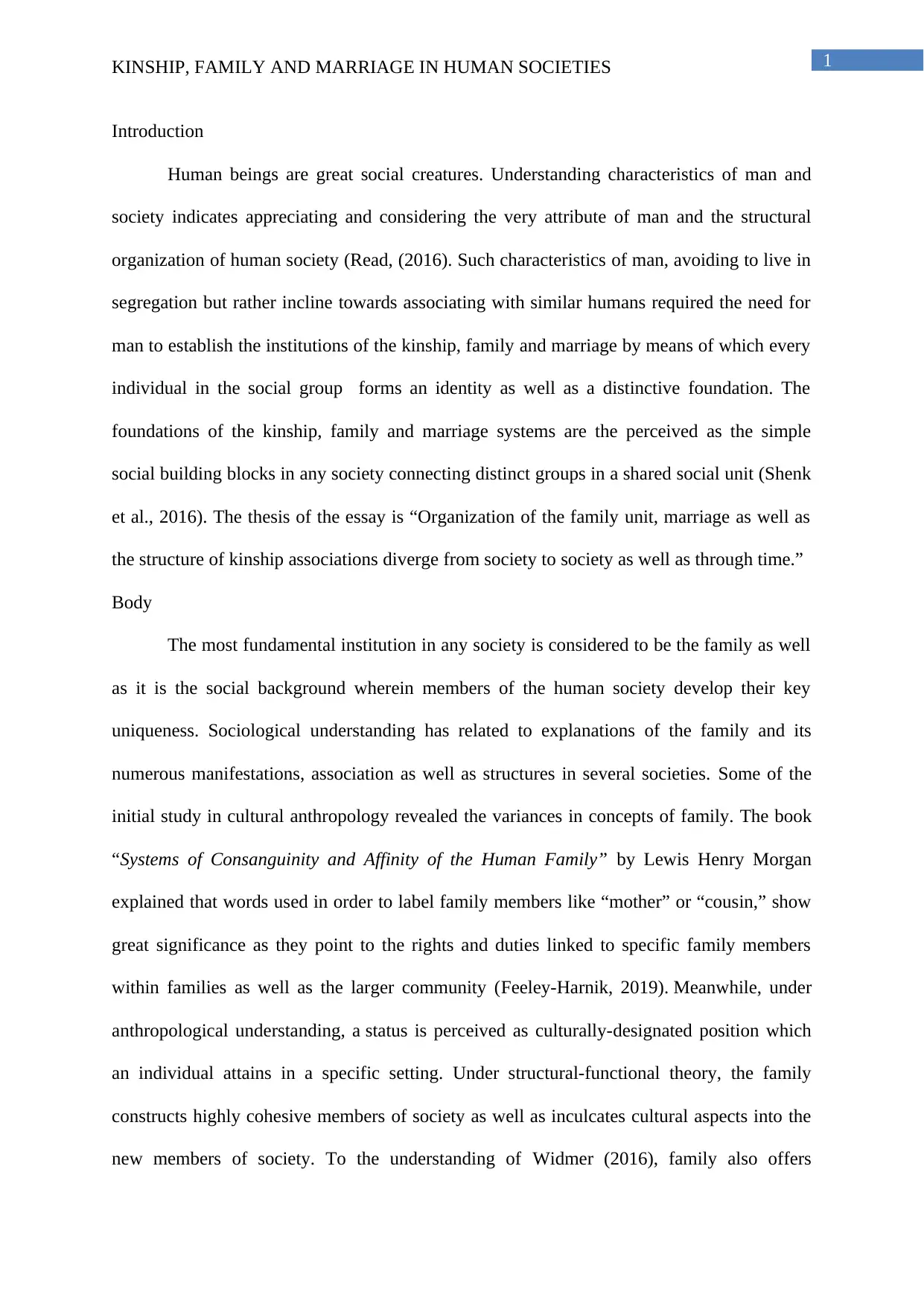
1KINSHIP, FAMILY AND MARRIAGE IN HUMAN SOCIETIES
Introduction
Human beings are great social creatures. Understanding characteristics of man and
society indicates appreciating and considering the very attribute of man and the structural
organization of human society (Read, (2016). Such characteristics of man, avoiding to live in
segregation but rather incline towards associating with similar humans required the need for
man to establish the institutions of the kinship, family and marriage by means of which every
individual in the social group forms an identity as well as a distinctive foundation. The
foundations of the kinship, family and marriage systems are the perceived as the simple
social building blocks in any society connecting distinct groups in a shared social unit (Shenk
et al., 2016). The thesis of the essay is “Organization of the family unit, marriage as well as
the structure of kinship associations diverge from society to society as well as through time.”
Body
The most fundamental institution in any society is considered to be the family as well
as it is the social background wherein members of the human society develop their key
uniqueness. Sociological understanding has related to explanations of the family and its
numerous manifestations, association as well as structures in several societies. Some of the
initial study in cultural anthropology revealed the variances in concepts of family. The book
“Systems of Consanguinity and Affinity of the Human Family” by Lewis Henry Morgan
explained that words used in order to label family members like “mother” or “cousin,” show
great significance as they point to the rights and duties linked to specific family members
within families as well as the larger community (Feeley-Harnik, 2019). Meanwhile, under
anthropological understanding, a status is perceived as culturally-designated position which
an individual attains in a specific setting. Under structural-functional theory, the family
constructs highly cohesive members of society as well as inculcates cultural aspects into the
new members of society. To the understanding of Widmer (2016), family also offers
Introduction
Human beings are great social creatures. Understanding characteristics of man and
society indicates appreciating and considering the very attribute of man and the structural
organization of human society (Read, (2016). Such characteristics of man, avoiding to live in
segregation but rather incline towards associating with similar humans required the need for
man to establish the institutions of the kinship, family and marriage by means of which every
individual in the social group forms an identity as well as a distinctive foundation. The
foundations of the kinship, family and marriage systems are the perceived as the simple
social building blocks in any society connecting distinct groups in a shared social unit (Shenk
et al., 2016). The thesis of the essay is “Organization of the family unit, marriage as well as
the structure of kinship associations diverge from society to society as well as through time.”
Body
The most fundamental institution in any society is considered to be the family as well
as it is the social background wherein members of the human society develop their key
uniqueness. Sociological understanding has related to explanations of the family and its
numerous manifestations, association as well as structures in several societies. Some of the
initial study in cultural anthropology revealed the variances in concepts of family. The book
“Systems of Consanguinity and Affinity of the Human Family” by Lewis Henry Morgan
explained that words used in order to label family members like “mother” or “cousin,” show
great significance as they point to the rights and duties linked to specific family members
within families as well as the larger community (Feeley-Harnik, 2019). Meanwhile, under
anthropological understanding, a status is perceived as culturally-designated position which
an individual attains in a specific setting. Under structural-functional theory, the family
constructs highly cohesive members of society as well as inculcates cultural aspects into the
new members of society. To the understanding of Widmer (2016), family also offers
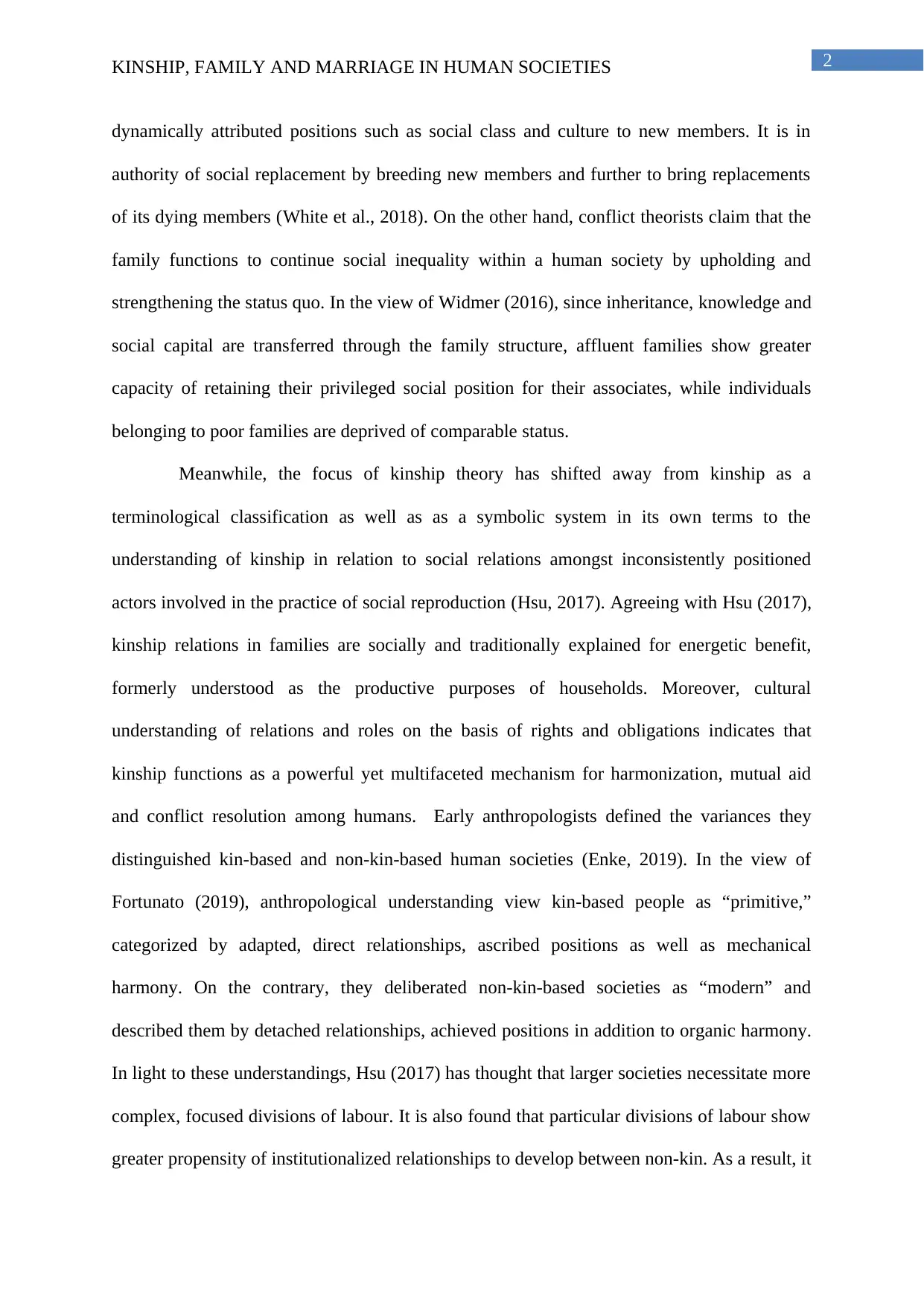
2KINSHIP, FAMILY AND MARRIAGE IN HUMAN SOCIETIES
dynamically attributed positions such as social class and culture to new members. It is in
authority of social replacement by breeding new members and further to bring replacements
of its dying members (White et al., 2018). On the other hand, conflict theorists claim that the
family functions to continue social inequality within a human society by upholding and
strengthening the status quo. In the view of Widmer (2016), since inheritance, knowledge and
social capital are transferred through the family structure, affluent families show greater
capacity of retaining their privileged social position for their associates, while individuals
belonging to poor families are deprived of comparable status.
Meanwhile, the focus of kinship theory has shifted away from kinship as a
terminological classification as well as as a symbolic system in its own terms to the
understanding of kinship in relation to social relations amongst inconsistently positioned
actors involved in the practice of social reproduction (Hsu, 2017). Agreeing with Hsu (2017),
kinship relations in families are socially and traditionally explained for energetic benefit,
formerly understood as the productive purposes of households. Moreover, cultural
understanding of relations and roles on the basis of rights and obligations indicates that
kinship functions as a powerful yet multifaceted mechanism for harmonization, mutual aid
and conflict resolution among humans. Early anthropologists defined the variances they
distinguished kin-based and non-kin-based human societies (Enke, 2019). In the view of
Fortunato (2019), anthropological understanding view kin-based people as “primitive,”
categorized by adapted, direct relationships, ascribed positions as well as mechanical
harmony. On the contrary, they deliberated non-kin-based societies as “modern” and
described them by detached relationships, achieved positions in addition to organic harmony.
In light to these understandings, Hsu (2017) has thought that larger societies necessitate more
complex, focused divisions of labour. It is also found that particular divisions of labour show
greater propensity of institutionalized relationships to develop between non-kin. As a result, it
dynamically attributed positions such as social class and culture to new members. It is in
authority of social replacement by breeding new members and further to bring replacements
of its dying members (White et al., 2018). On the other hand, conflict theorists claim that the
family functions to continue social inequality within a human society by upholding and
strengthening the status quo. In the view of Widmer (2016), since inheritance, knowledge and
social capital are transferred through the family structure, affluent families show greater
capacity of retaining their privileged social position for their associates, while individuals
belonging to poor families are deprived of comparable status.
Meanwhile, the focus of kinship theory has shifted away from kinship as a
terminological classification as well as as a symbolic system in its own terms to the
understanding of kinship in relation to social relations amongst inconsistently positioned
actors involved in the practice of social reproduction (Hsu, 2017). Agreeing with Hsu (2017),
kinship relations in families are socially and traditionally explained for energetic benefit,
formerly understood as the productive purposes of households. Moreover, cultural
understanding of relations and roles on the basis of rights and obligations indicates that
kinship functions as a powerful yet multifaceted mechanism for harmonization, mutual aid
and conflict resolution among humans. Early anthropologists defined the variances they
distinguished kin-based and non-kin-based human societies (Enke, 2019). In the view of
Fortunato (2019), anthropological understanding view kin-based people as “primitive,”
categorized by adapted, direct relationships, ascribed positions as well as mechanical
harmony. On the contrary, they deliberated non-kin-based societies as “modern” and
described them by detached relationships, achieved positions in addition to organic harmony.
In light to these understandings, Hsu (2017) has thought that larger societies necessitate more
complex, focused divisions of labour. It is also found that particular divisions of labour show
greater propensity of institutionalized relationships to develop between non-kin. As a result, it
⊘ This is a preview!⊘
Do you want full access?
Subscribe today to unlock all pages.

Trusted by 1+ million students worldwide

3KINSHIP, FAMILY AND MARRIAGE IN HUMAN SOCIETIES
is not unforeseen that kinship serves a reduced role in majority of the modern Western
societies. Meanwhile, recent kinship studies have accepted the ethnocentrism rooted in
primary studies and currently the understanding of individuals has been considered as a
dynamic important characteristic of human society (Enke, 2019). Study has mentioned that in
human kinship systems, families are the building blocks for linkages of connections that
establish most significant kinship ecologies. Connections between families are typically
established conjugal associations. Devoid of these conjugal associations and recognition of
paternity, these organizations could not be as culturally extensive. Fortunato (2019) has
argued that pair bonding also establishes the essential conditions for basic kinship formation
by means of reliable paternity recognition. However, it is certain that acknowledgement of
maternal as well as paternal kin multiplies the set of potential kinship associations and agrees
to the complexity which appears in human kinship systems. On the other hand, Enke (2019)
have emphasized on the bilateral system which explicitly explains an arrangement of property
inheritance structure wherein the ego become heir to property.
Additionally, it is proclaimed that societies which comprise non-unilineal kinship
systems are labelled as bilateral, cognatic, multilineal or sometimes omnilineal whereby an
individual is connected to numerous groups of kinsmen through paternal linkages. In the view
of Hsu (2017), majority of the Canadian societies comprise bilateral descent, in which people
are connected to the kin of both parentages. On the other hand, in patrilineal descent, greater
emphasis is given on the forefather’s side of the family and with matrilineal lineage; the
maternal’s side of the family is underlined. Time and again, reproductive descriptions align
with these types of lineages through denial or by emphasizing on the roles of one side over
the other after the reproduction of the child (White et al., 2018).
Under anthropological understanding, marriage is considered as a relation of one or
more men and women and is accepted by custom or law. This further takes into account
is not unforeseen that kinship serves a reduced role in majority of the modern Western
societies. Meanwhile, recent kinship studies have accepted the ethnocentrism rooted in
primary studies and currently the understanding of individuals has been considered as a
dynamic important characteristic of human society (Enke, 2019). Study has mentioned that in
human kinship systems, families are the building blocks for linkages of connections that
establish most significant kinship ecologies. Connections between families are typically
established conjugal associations. Devoid of these conjugal associations and recognition of
paternity, these organizations could not be as culturally extensive. Fortunato (2019) has
argued that pair bonding also establishes the essential conditions for basic kinship formation
by means of reliable paternity recognition. However, it is certain that acknowledgement of
maternal as well as paternal kin multiplies the set of potential kinship associations and agrees
to the complexity which appears in human kinship systems. On the other hand, Enke (2019)
have emphasized on the bilateral system which explicitly explains an arrangement of property
inheritance structure wherein the ego become heir to property.
Additionally, it is proclaimed that societies which comprise non-unilineal kinship
systems are labelled as bilateral, cognatic, multilineal or sometimes omnilineal whereby an
individual is connected to numerous groups of kinsmen through paternal linkages. In the view
of Hsu (2017), majority of the Canadian societies comprise bilateral descent, in which people
are connected to the kin of both parentages. On the other hand, in patrilineal descent, greater
emphasis is given on the forefather’s side of the family and with matrilineal lineage; the
maternal’s side of the family is underlined. Time and again, reproductive descriptions align
with these types of lineages through denial or by emphasizing on the roles of one side over
the other after the reproduction of the child (White et al., 2018).
Under anthropological understanding, marriage is considered as a relation of one or
more men and women and is accepted by custom or law. This further takes into account
Paraphrase This Document
Need a fresh take? Get an instant paraphrase of this document with our AI Paraphraser
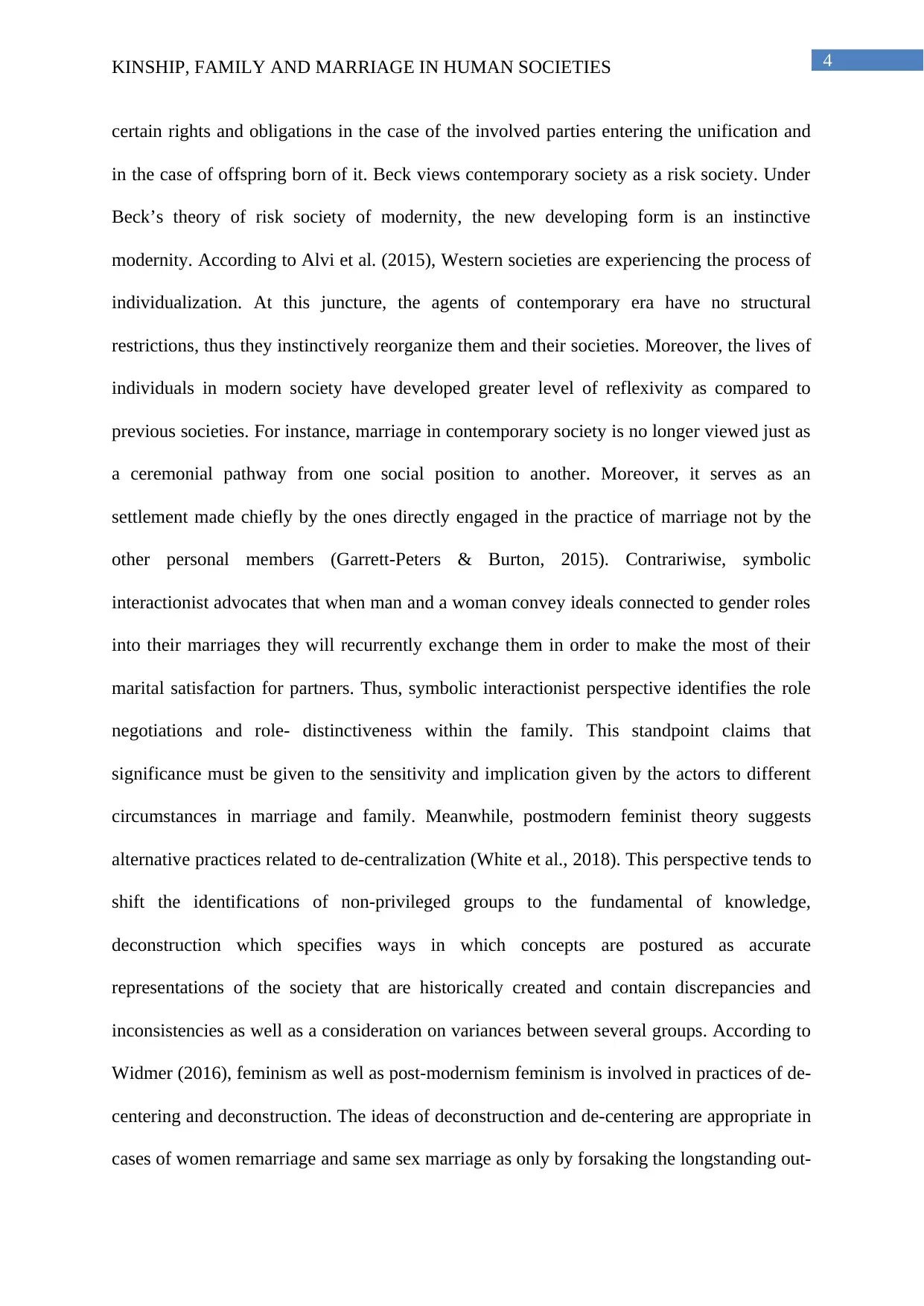
4KINSHIP, FAMILY AND MARRIAGE IN HUMAN SOCIETIES
certain rights and obligations in the case of the involved parties entering the unification and
in the case of offspring born of it. Beck views contemporary society as a risk society. Under
Beck’s theory of risk society of modernity, the new developing form is an instinctive
modernity. According to Alvi et al. (2015), Western societies are experiencing the process of
individualization. At this juncture, the agents of contemporary era have no structural
restrictions, thus they instinctively reorganize them and their societies. Moreover, the lives of
individuals in modern society have developed greater level of reflexivity as compared to
previous societies. For instance, marriage in contemporary society is no longer viewed just as
a ceremonial pathway from one social position to another. Moreover, it serves as an
settlement made chiefly by the ones directly engaged in the practice of marriage not by the
other personal members (Garrett‐Peters & Burton, 2015). Contrariwise, symbolic
interactionist advocates that when man and a woman convey ideals connected to gender roles
into their marriages they will recurrently exchange them in order to make the most of their
marital satisfaction for partners. Thus, symbolic interactionist perspective identifies the role
negotiations and role- distinctiveness within the family. This standpoint claims that
significance must be given to the sensitivity and implication given by the actors to different
circumstances in marriage and family. Meanwhile, postmodern feminist theory suggests
alternative practices related to de-centralization (White et al., 2018). This perspective tends to
shift the identifications of non-privileged groups to the fundamental of knowledge,
deconstruction which specifies ways in which concepts are postured as accurate
representations of the society that are historically created and contain discrepancies and
inconsistencies as well as a consideration on variances between several groups. According to
Widmer (2016), feminism as well as post-modernism feminism is involved in practices of de-
centering and deconstruction. The ideas of deconstruction and de-centering are appropriate in
cases of women remarriage and same sex marriage as only by forsaking the longstanding out-
certain rights and obligations in the case of the involved parties entering the unification and
in the case of offspring born of it. Beck views contemporary society as a risk society. Under
Beck’s theory of risk society of modernity, the new developing form is an instinctive
modernity. According to Alvi et al. (2015), Western societies are experiencing the process of
individualization. At this juncture, the agents of contemporary era have no structural
restrictions, thus they instinctively reorganize them and their societies. Moreover, the lives of
individuals in modern society have developed greater level of reflexivity as compared to
previous societies. For instance, marriage in contemporary society is no longer viewed just as
a ceremonial pathway from one social position to another. Moreover, it serves as an
settlement made chiefly by the ones directly engaged in the practice of marriage not by the
other personal members (Garrett‐Peters & Burton, 2015). Contrariwise, symbolic
interactionist advocates that when man and a woman convey ideals connected to gender roles
into their marriages they will recurrently exchange them in order to make the most of their
marital satisfaction for partners. Thus, symbolic interactionist perspective identifies the role
negotiations and role- distinctiveness within the family. This standpoint claims that
significance must be given to the sensitivity and implication given by the actors to different
circumstances in marriage and family. Meanwhile, postmodern feminist theory suggests
alternative practices related to de-centralization (White et al., 2018). This perspective tends to
shift the identifications of non-privileged groups to the fundamental of knowledge,
deconstruction which specifies ways in which concepts are postured as accurate
representations of the society that are historically created and contain discrepancies and
inconsistencies as well as a consideration on variances between several groups. According to
Widmer (2016), feminism as well as post-modernism feminism is involved in practices of de-
centering and deconstruction. The ideas of deconstruction and de-centering are appropriate in
cases of women remarriage and same sex marriage as only by forsaking the longstanding out-
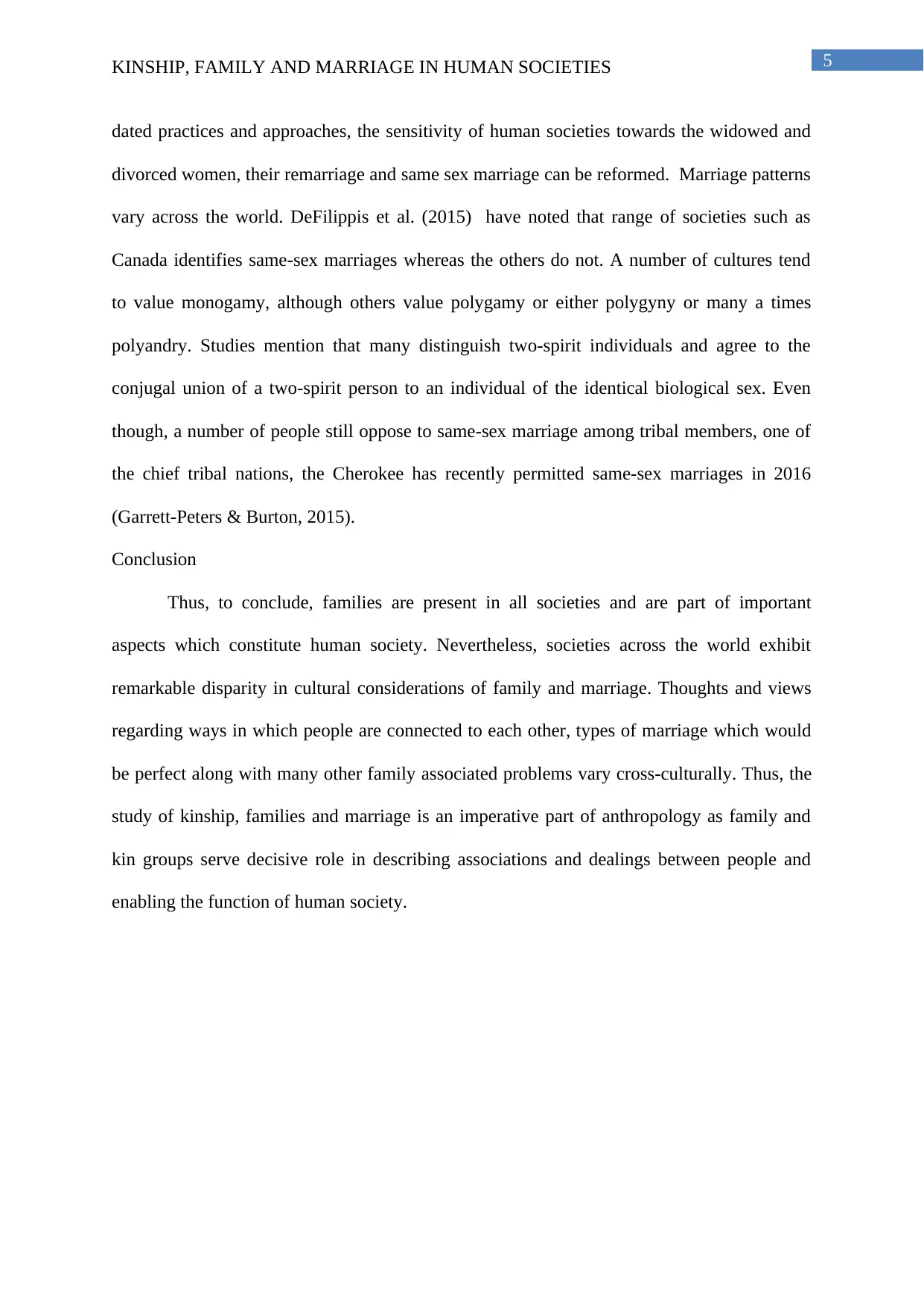
5KINSHIP, FAMILY AND MARRIAGE IN HUMAN SOCIETIES
dated practices and approaches, the sensitivity of human societies towards the widowed and
divorced women, their remarriage and same sex marriage can be reformed. Marriage patterns
vary across the world. DeFilippis et al. (2015) have noted that range of societies such as
Canada identifies same-sex marriages whereas the others do not. A number of cultures tend
to value monogamy, although others value polygamy or either polygyny or many a times
polyandry. Studies mention that many distinguish two-spirit individuals and agree to the
conjugal union of a two-spirit person to an individual of the identical biological sex. Even
though, a number of people still oppose to same-sex marriage among tribal members, one of
the chief tribal nations, the Cherokee has recently permitted same-sex marriages in 2016
(Garrett‐Peters & Burton, 2015).
Conclusion
Thus, to conclude, families are present in all societies and are part of important
aspects which constitute human society. Nevertheless, societies across the world exhibit
remarkable disparity in cultural considerations of family and marriage. Thoughts and views
regarding ways in which people are connected to each other, types of marriage which would
be perfect along with many other family associated problems vary cross-culturally. Thus, the
study of kinship, families and marriage is an imperative part of anthropology as family and
kin groups serve decisive role in describing associations and dealings between people and
enabling the function of human society.
dated practices and approaches, the sensitivity of human societies towards the widowed and
divorced women, their remarriage and same sex marriage can be reformed. Marriage patterns
vary across the world. DeFilippis et al. (2015) have noted that range of societies such as
Canada identifies same-sex marriages whereas the others do not. A number of cultures tend
to value monogamy, although others value polygamy or either polygyny or many a times
polyandry. Studies mention that many distinguish two-spirit individuals and agree to the
conjugal union of a two-spirit person to an individual of the identical biological sex. Even
though, a number of people still oppose to same-sex marriage among tribal members, one of
the chief tribal nations, the Cherokee has recently permitted same-sex marriages in 2016
(Garrett‐Peters & Burton, 2015).
Conclusion
Thus, to conclude, families are present in all societies and are part of important
aspects which constitute human society. Nevertheless, societies across the world exhibit
remarkable disparity in cultural considerations of family and marriage. Thoughts and views
regarding ways in which people are connected to each other, types of marriage which would
be perfect along with many other family associated problems vary cross-culturally. Thus, the
study of kinship, families and marriage is an imperative part of anthropology as family and
kin groups serve decisive role in describing associations and dealings between people and
enabling the function of human society.
⊘ This is a preview!⊘
Do you want full access?
Subscribe today to unlock all pages.

Trusted by 1+ million students worldwide

6KINSHIP, FAMILY AND MARRIAGE IN HUMAN SOCIETIES
References
Alvi, S., Downing, S., & Cesaroni, C. (2015). The Self and the ‘Selfie’: Cyber-Bullying
Theory and the Structure of Late Modernity', Violence and Crime in the Family:
Patterns, Causes, and Consequences (Contemporary Perspectives in Family Research,
Volume 9).
DeFilippis, J. N., Anderson-Nathe, B., & Panichelli, M. (2015). Notes on same-sex marriage:
Concerns for feminist social workers. Affilia, 30(4), 461-475.
Enke, B. (2019). Kinship, cooperation, and the evolution of moral systems. The Quarterly
Journal of Economics, 134(2), 953-1019.
Feeley-Harnik, G. (2019). Lewis Henry Morgan: American Beavers and Their
Works. Ethnos, 1-23.
Fortunato, L. (2019). Lineal kinship organization in cross-specific perspective. Philosophical
Transactions of the Royal Society B, 374(1780), 20190005.
Garrett‐Peters, R., & Burton, L. M. (2015). Reframing marriage and marital delay among
low‐income mothers: An interactionist perspective. Journal of Family Theory &
Review, 7(3), 242-264.
Hsu, F. L. (Ed.). (2017). Kinship and culture. Routledge.
Jones, D., & Milicic, B. (2015). Kinship, language, and prehistory: Per Hage and the
renaissance in kinship studies. University of Utah Press.
Read, D. W. (2016). How culture makes us human: primate social evolution and the
formation of human societies. Routledge.
Shenk, M. K., Towner, M. C., Voss, E. A., & Alam, N. (2016). Consanguineous marriage,
kinship ecology, and market transition. Current Anthropology, 57(S13), S167-S180.
White, J. M., Martin, T. F., & Adamsons, K. (2018). Family theories: An introduction. Sage
Publications.
References
Alvi, S., Downing, S., & Cesaroni, C. (2015). The Self and the ‘Selfie’: Cyber-Bullying
Theory and the Structure of Late Modernity', Violence and Crime in the Family:
Patterns, Causes, and Consequences (Contemporary Perspectives in Family Research,
Volume 9).
DeFilippis, J. N., Anderson-Nathe, B., & Panichelli, M. (2015). Notes on same-sex marriage:
Concerns for feminist social workers. Affilia, 30(4), 461-475.
Enke, B. (2019). Kinship, cooperation, and the evolution of moral systems. The Quarterly
Journal of Economics, 134(2), 953-1019.
Feeley-Harnik, G. (2019). Lewis Henry Morgan: American Beavers and Their
Works. Ethnos, 1-23.
Fortunato, L. (2019). Lineal kinship organization in cross-specific perspective. Philosophical
Transactions of the Royal Society B, 374(1780), 20190005.
Garrett‐Peters, R., & Burton, L. M. (2015). Reframing marriage and marital delay among
low‐income mothers: An interactionist perspective. Journal of Family Theory &
Review, 7(3), 242-264.
Hsu, F. L. (Ed.). (2017). Kinship and culture. Routledge.
Jones, D., & Milicic, B. (2015). Kinship, language, and prehistory: Per Hage and the
renaissance in kinship studies. University of Utah Press.
Read, D. W. (2016). How culture makes us human: primate social evolution and the
formation of human societies. Routledge.
Shenk, M. K., Towner, M. C., Voss, E. A., & Alam, N. (2016). Consanguineous marriage,
kinship ecology, and market transition. Current Anthropology, 57(S13), S167-S180.
White, J. M., Martin, T. F., & Adamsons, K. (2018). Family theories: An introduction. Sage
Publications.
Paraphrase This Document
Need a fresh take? Get an instant paraphrase of this document with our AI Paraphraser
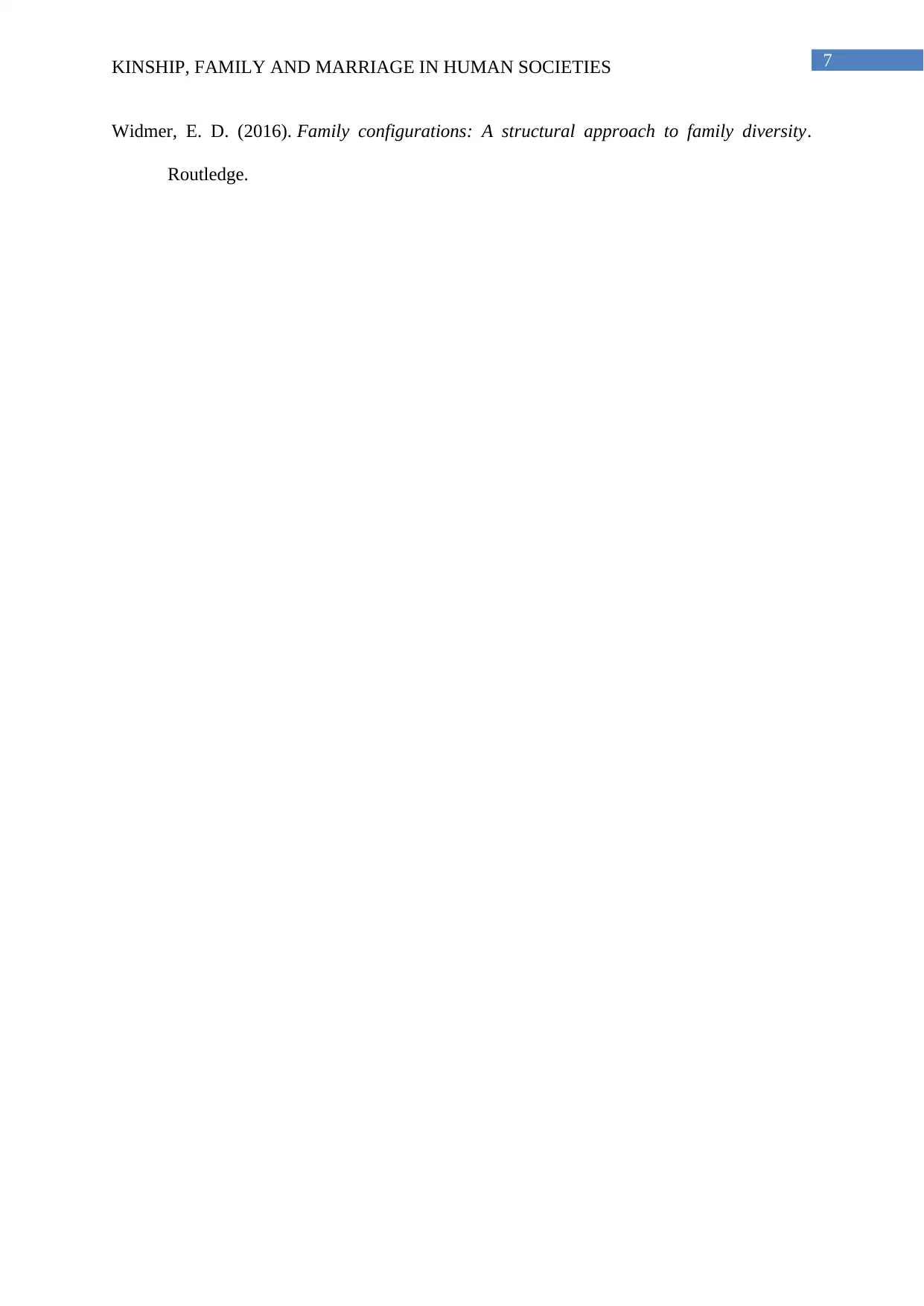
7KINSHIP, FAMILY AND MARRIAGE IN HUMAN SOCIETIES
Widmer, E. D. (2016). Family configurations: A structural approach to family diversity.
Routledge.
Widmer, E. D. (2016). Family configurations: A structural approach to family diversity.
Routledge.
1 out of 8
Related Documents
Your All-in-One AI-Powered Toolkit for Academic Success.
+13062052269
info@desklib.com
Available 24*7 on WhatsApp / Email
![[object Object]](/_next/static/media/star-bottom.7253800d.svg)
Unlock your academic potential
Copyright © 2020–2025 A2Z Services. All Rights Reserved. Developed and managed by ZUCOL.





